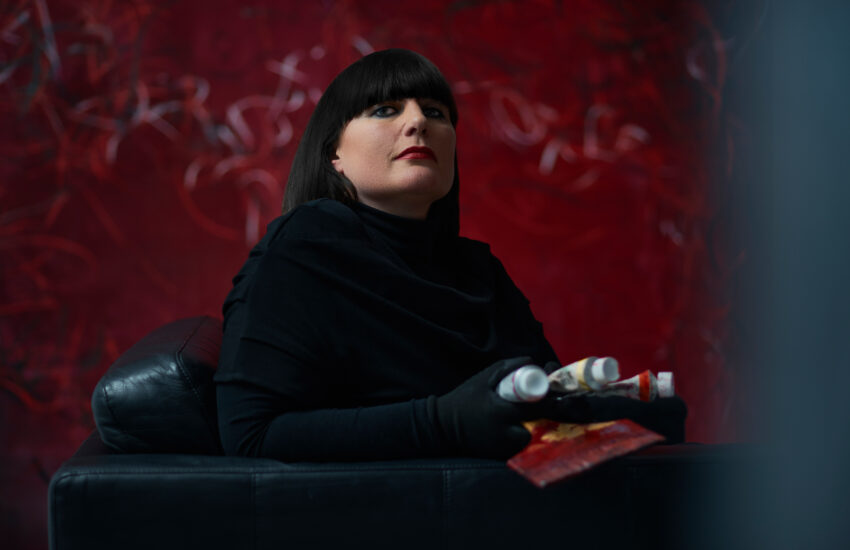Anette C. Halm’s performances, videos, and paintings are mutually
dependent. Whereas for other artists, works in different artistic media appear
as more or less autonomous groups – independent of one another – in Halm’s
case, close causal connections clearly reveal the inner relationships between pieces,
both in terms of content and form. Instead of following a script that has been formulated
down to the last detail or working with a polished storyboard, Anette C. Halm
develops her performances in the process of creating her large-format canvases
– out of the symptomatic action of making each painting. By the same token, the
artist’s current paintings do not start from sketches or small-scale studies on
paper, but are generated, to a certain extent, from what Halm has directly seen
and experienced in her filmic work elsewhere. Given this complex transmedial
approach – between moving and seemingly static images – it is only fitting that
in the exhibition context, selected video stills by the artist can stand for
the entire set of a performance and can thus be brought together as a whole in
an edition of photographs.
To date, Anette C. Halm has created a comprehensive
performance project titled Kunst am Wegesrand (Art by the Wayside) in several
German cities, including Nürtingen and Ostfildern. Other iterations – also
beyond the region of southwestern Germany – are presently in the planning stage.
Working together with nationally and internationally active performance artists,
she examines the individual life stories and impact of prominent, predominantly
female figures from the region’s history during various cultural epochs, using actual
historical sites as a backdrop. The audience can experience the elaborately
staged actions live on-site during each performance or access them afterward in
public locations via a specially developed smartphone app of the same name,
Kunst am Wegesrand. In this way, parts of cultural heritage that are all too
often forgotten are preserved in popular consciousness right up to the present
and are made easily accessible to a young audience that may not have a
particular affinity for art.
While earlier bodies of work by Anette C. Halm focused
primarily on autobiographical experiences (for example, 12 Ways To Leave Your
Lover, 2015; My Daughter Looking At Me, Looking At Eva Ionesco, 2018, among
others), Kunst am Wegesrand expands the view beyond the individual and across
time. The impulse, which reaches the limits of the self-destructive private in
the present, is brought into relation with past female role models and clichés
imposed by society and culture in all facets of life. Through the participation
of numerous artists invited to show their work at completely different
locations, the project is now effectively linked across regional borders.
In a similar way, Anette C. Halm applies this supra-individual
immediacy to the medium of painting. Thinking About Video Art, a series of
large-format paintings created since 2008, is characterized by an intensely
colorful, non-objective, non-figurative approach. Nevertheless, these paintings
express physical perceptions that are determined by the painter’s physical
radius of activity, thus defining her own “space of action.” Not unlike the basic
conditions in film, the staging of color is carried out in serial phases to
investigate the emotional supremacy of a single hue (a mood significant for the
scene in question), the choreography of lighting, the concretization of form,
and, conversely, its fading into the indeterminate and diffuse.
Given Anette C. Halm’s merging of painterly and cinematic
techniques, the steps she has taken since 2022 seem quite logical. Following
her intuition, she breaks down a number of these large-format paintings into
smaller segments of “cuts” (each approximately 30 by 30 centimeters). In this
process, a singular experience is considered and critically examined multiple
times over. The individual excerpted images are edited into an almost cinematic
sequence and synchronized to form a plausible continuum. In freely combinable
sequences, the presentation of these series results in a new, inherently
dynamic dramaturgy of form and color. Simultaneously, the artist has also recently
begun to create painted Mind Samples as “test shots” in small format on paper,
allowing her to experiment with the colors in question and with new
compositional approaches and found painterly structures before working within
the considerably larger space of the canvas.
The term “mind sample” is particularly apt to describe the
conceptual approach and effect of Anette C. Halm’s work. The boundaries between
the seemingly static and moving image – here of painting and performance, there
of photography and video; of once firmly frozen memories on the one hand and
the imaginative memory of something that was very much alive on the other – are
easily transcended and rendered visible and intelligible in various artistic
media. One thing is unthinkable without the other.
Clemens Ottnad
Artist Anette C. Halm photographed by Dimitri Reimer in her studio at the Art Academy in Nürtingen. https://reimer-photograph.com/portfolio/menschmontag_anettechalm/

